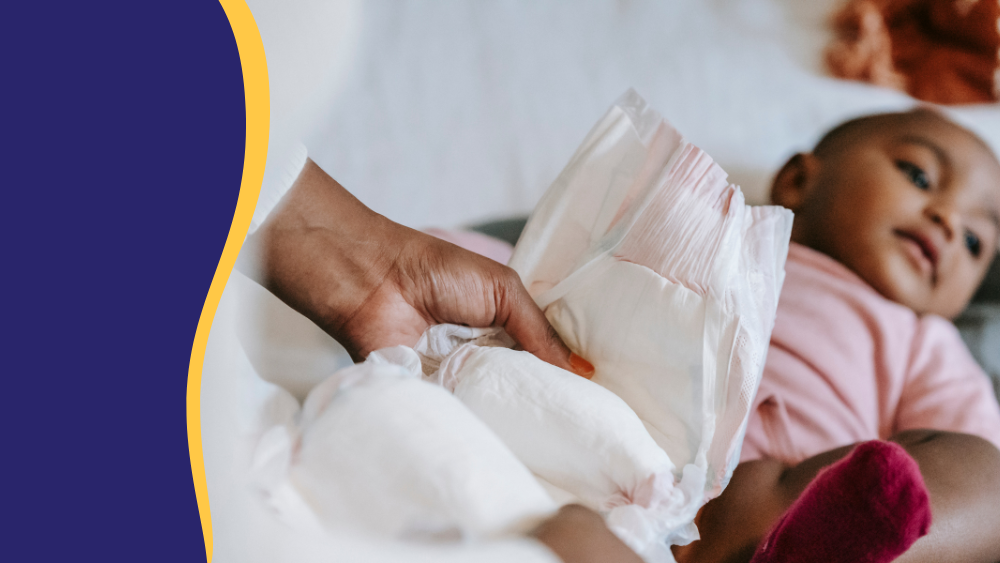Highlights
- Half of U.S. families struggle with a diaper need
- Diaper need is a growing problem in America
- Barriers to keeping a baby clean and dry are a strong risk factor for maternal depression
- There is little U.S. infrastructure providing families access to diapers
Background
Diaper need (DN) is defined as “the lack of a sufficient supply of diapers to keep a baby or toddler clean, dry, and healthy.”1
Diaper Need (DN) and Maternal Mental Health
- DN is a growing problem in America,1 with half of U.S. families struggling with DN.2
- DN diminishes maternal sense of competence and increases maternal stress, which elevates the risk for maternal mental health disorders.3
- DN increases the risk for poor infant and child health, which can increase maternal distress and negatively impact child development.1,3
- DN is the number one material hardship contributing to maternal depression over hardships such as food insecurity.4
Financial Hardship:
- Families facing financial hardship spend 14% of their income on diapers, creating additional financial and psychological stress.5
- Women with four socioeconomic status (SES) risk factors (low monthly income, less than a college education, unmarried, unemployed) are 11 times more likely than women with no SES risk factors to have clinically elevated postpartum depression scores.6
- For families who are financially struggling, it’s not only food and housing but also diapers that must be recognized as a basic need.3
Rural Diaper Access, Childcare, and Maternal Mental Health
- Families facing geographic barriers to diaper access have further elevated risk for mental health challenges.7
- 1 in 4 parents miss work or school because they can’t afford the diapers required by childcare providers.1
- Psychological stress caused by childcare issues is one of the strongest predictors of maternal depression.8
Opportunities
Federal Programs are Failing to Support Diaper Access:
There is little U.S. infrastructure providing families access to diapers. Community diaper banks are attempting to fill this massive void but are not positioned to support all U.S. families in need.4
Federal nutrition programs SNAP and WIC do not cover diapers.5
- SNAP and WIC: Supplemental Nutrition Assistance Program (SNAP, also known as food stamps) and the Special Supplemental Nutrition Program for Women, Infants and Children (WIC).
Temporary Assistance for Needy Families (TANF) beneficiaries may need to choose between buying diapers and other necessities.5
The Child Tax Credit lifted almost 3 million children and families out of supplemental poverty (SPM) in 2021, but only about 1.4 million in 2023.9
Policymaker Action Urged
Policymakers can recognize and address the connection between material hardship, diaper need, and maternal mental health, taking immediate action to systematize access to diapers to improve health outcomes for mothers and babies.
References
- National Diaper Bank Network. (n.d.). National Diaper Bank Network. Retrieved December 12, 2024, from https://nationaldiaperbanknetwork.org/ ↩︎
- National Diaper Bank Network. (2023). The NDBN Diaper Check 2023: Diaper Insecurity among U.S. Children and Families. https://nationaldiaperbanknetwork.org/wp-content/uploads/2023/06/NDBN-Diaper-Check-2023_Executive-Summary-FINAL.pdf ↩︎
- Smith, M. V., Kruse, A., Weir, A., & Goldblum, J. (2013). Diaper Need and Its Impact on Child Health. Pediatrics, 132(2), 253–259. https://doi.org/10.1542/peds.2013-0597 ↩︎
- Austin, A. E., & Smith, M. V. (2017). Examining Material Hardship in Mothers: Associations of Diaper Need and Food Insufficiency with Maternal Depressive Symptoms. Health Equity, 1(1), 127–133. https://doi.org/10.1089/heq.2016.0023 ↩︎
- Center for Economic and Policy Research. (2015, November 23). Policies Like the Hygiene Assistance for Families of Infants and Toddlers Act Will Help the Poor Pay for Diapers. https://www.cepr.net/the-hygiene-assistance-for-families-of-infants-and-toddlers-act-will-help-the-poor-pay-for-diapers/ ↩︎
- Goyal, D., Gay, C., & Lee, K. A. (2010). How much does Low Socioeconomic Status Increase the Risk of Prenatal and Postpartum Depressive Symptoms in First Time Mothers? Women’s Health Issues : Official Publication of the Jacobs Institute of Women’s Health, 20(2), 96–104. https://doi.org/10.1016/j.whi.2009.11.003 ↩︎
- Massengale, K. E. C., Jones, M. A., Liao, J., Park, C., & Old, M. (2022). Priority Areas for Child Diaper Access: Low-Income Neighborhoods with Limited Retail Access to the Basic Need of Diapers. Health Equity, 6(1), 767–776. https://doi.org/10.1089/heq.2021.0192 ↩︎
- Beck, C. T. (2001). Predictors of postpartum depression: An update. Nursing Research, 50(5), 275–285. https://doi.org/10.1097/00006199-200109000-00004 ↩︎
- The White House. (2023, November 20). The Anti-Poverty and Income-Boosting Impacts of the Enhanced CTC | CEA. The White House. https://www.whitehouse.gov/cea/written-materials/2023/11/20/the-anti-poverty-and-income-boosting-impacts-of-the-enhanced-ctc/ ↩︎



